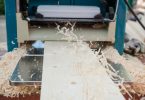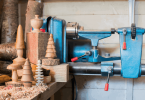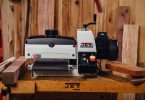Nowadays you will rarely find a woodworking store or construction project not employing the use of a brad nailer. This is a must-have tool for any carpenter or craftsman that needs to make the task of fastening wood pieces easier and faster.
If you’re in need of a brad nailer, you might find it hard to find your best match from so many choices. Here at Drillly we can help you just with that because we tested and reviewed several of these power tools and then prepared a top 10 list based on our findings.
So, check out our review and buying guide and make your choice today!
Our Handpicked 10 Best Brad Nailers Reviewed
Our review is fascinating in that it features nailers from eight different manufacturers. Many product reviews end up getting dominated by four or five tool companies, simply because they transfer many of their good ideas to more than one model in their line-up. But it turns out, may companies have “nailed it” when it comes to offering a top-rated brad nailer.
01 WEN 61720 (Our Pick)

Why We Recommend This Product?
Frankly, our top pick is so cheap that you might wonder what’s wrong with it. So did I. But after driving hundreds of brads perfectly, without a single jam or misfire, I am convinced. So are real-world owners that made it one of the best rated nail guns on different eStores.
Detailed Review
The Wen 61720 can be loaded with brads from ¾ to 2 inches in length. Adjustment for the varying lengths is a simple spindle wheel under the trigger.
The entire nailer weighs just three pounds, thanks to its aluminum frame. The rubber handle is easy on your hands, and the nailer’s perfect balance adds to the ease of use. This machine is powered from your separate compressor, and works with pressure anywhere from 60 to 100 psi. The magazine holds up to 100 brads, so reloading is an infrequent exercise.
So is clearing jams. Users report that this nailer almost never jams. If it ever does, there is a quick release latch on the nose to clear jams in an instant. Speaking of the nose, there is a little safety mechanism upfront that will not allow the gun to fire a brad unless the nose is firmly in contact with the wood’s surface.
As for nifty features, I like the directional exhaust port on top that allows you to point the expelled air in any direction. Another plus is the easy to read markings on the side of the magazine that lets you know how many nails are left in your load.
Pros
- Flat-out cheap
- Highly reliable
- Great Ergonomics
Cons
- Lacks some features of more expensive units
Final Verdict
You may find an 18 gauge model that has more bells and whistles than this one, and that may be what you want. If you do trim work for a living, maybe this one isn’t heavy-duty enough for you. But I have to say, for the overwhelming majority of people, they would be hard-pressed to find a machine that will serve their purposes any better than this one. It does the job very well and coming at around $25, it won’t bust your budget in the process.
02 Stanley TRE550Z (Great Bang for the Buck)

Why We Recommend This Product?
Think dual purpose. This is an electric brad nail gun that doubles as an electric stapler. Yup, not only can you use it as a brad nailer, but just load it up with heavy-duty staples and you can finish that insulation job as well.
Detailed Review
For around $30, Stanley offers this versatile machine that can fire brads or staples. It also has two power settings (Hi/Lo) for driving brads or staples into hard or soft materials.
It looks and feels more like a stapler than most brad nailers, and it actually is. The biggest drawback is that it only fires brads in three relatively short lengths of 1/2”, 9/16”, and 5/8”. There is an indicator window, so you can see when the brad load is getting low.
The brads (and staples) are fired from the very tip of the nose, so getting into tight spaces is easy. There is also a safety on the nose, so accidental firing won’t happen. It is electrically operated and has an eight-foot cord. The body of this brad nailer/stapler is plastic in Stanley’s traditional bright yellow.
Pros
- Uses staples or brads
- 2 power settings
Cons
- Can only use 3 very short brad sizes
Final Verdict
This electric brad nailer/stapler can be a handy tool for many homeowners. It can also be a good choice for wood workers who specialize in cabinetry and other pieces that require small brads. But for larger jobs that require longer brads, you would be better off buying another nailer on our list that’ll give good value for money.
03 Porter-Cable PCC790LA (Top Cordless Choice)
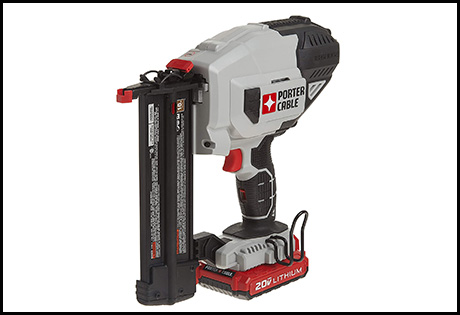
Why We Recommend This Product?
With no cords and no air hose, this cordless nailer lets you put an 18 gauge brad anywhere you want. Accurate depth adjustment with a thumbwheel can be verified in a window that lets you see exactly where you have it set.
The included lithium battery and charger means it isn’t cheap, but I think this is still a good buy.
Detailed Review
Ditch the pneumatic hose and air compressor. Ditch the electric cable and extension cords. Go cordless and be free! That’s just one of many advantages that put this machine very high in my brad nailer reviews.
Porter-Cable says this machine can fire as many as 1,300 nails per battery charge. That’s 13 complete magazines full of 18 gauge brads – more than I ever plan to fire in a single day. It will handle brads ranging from 5/8” up to 2 inches. It also has a sequential firing mode so you can “bump” fire brads like a framing nailer.
Here’s another really great thing that battery will power; there are two multi-function L.E.D.’s on this nailer that light up your work area. If you’ve ever been hunched over quarter molding in the dark corner of a room, you’ll appreciate how valuable this feature is.
Now, the battery does mean that the unit weighs 5.9 pounds. But the balance is quite nice and, if you’re accustomed to battery-powered tools, it’s nothing new.
A 20V lithium battery and charger are included in the kit, which will set you back around $180. However, it is the same battery that powers many other Porter- Cable tools. If you go that route, the battery system is an investment that you can spread over a range of uses.
Pros
- Cordless and hoseless
- Excellent depth adjustment system
- Trigger lock
Cons
- Expensive
- A few users have reported jamming problems
Final Verdict
I wish all cordless tool makers could agree on a battery design, so that we would only have to invest in one style of battery for all tools. Alas, it is not so. That means you have to pick a brand for your cordless tools, and stick with them. This nailer may very well convince you that Porter-Cable is the way to go. It is an excellent machine in every way, and most online reviews from owners are glowing testimonials.
It works great, has a lot of handy features (I really like the work lights), and can be your choice if you prefer a cordless model.
04 BOSTITCH BTFP12233 (Beginner’s Choice)
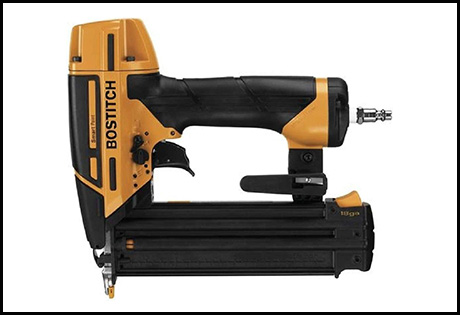
Why We Recommend This Product?
Because it’s not just for beginners. If this is the first brad nailer you ever buy, it may very well be the last. It is going to do everything you need a brad nailer to do, for as long as you need. This is a very good nail gun that won’t set you back a lot of money.
Detailed Review
This is an oil-free pneumatic nail gun from Bostitch that can drive brads ranging from 5/8” to 2 1/8 inches in length. It boasts of a trademarked “Dial-a-depth” system that lets you easily set the precise countersinking of the brads that you want.
It fires those brads through a small nose that Bostitch calls a “Smart Point”, also a trademarked term. That means that you do not have to push the tip into the surface of the material in order to fire the brad. The trigger is selectable, allowing you to go from sequential firing to bump actuation.
Here’s something I don’t like. This nailer funnels the exhaust air through a port in the bottom of the handle. That seems fine until you trigger it in a place where there is a little dust on the surface, and the dust blows up in your face. Yes, I had my safety glasses on, but a faceful of sawdust is never a positive experience.
For around $90 this isn’t the best budget brad nailer, but you will be buying a pneumatic brad gun that won’t let you down.
Pros
- Quality build
- Small nose for precise placement
- Easy adjustment for nail length
Cons
- Exhaust port under the handle kicks up dust
Final Verdict
This brad nailer stands up well in comparison with other systems in the same price range. Aside from the fairly petty complaint about the exhaust port, I think this is an amazing 18 gauge pneumatic nailer for the money.
05 Dewalt DWFP12231 (Top Pneumatic Choice)

Why We Recommend This Product?
The first things I look for in a tool are what I call the “Double D’s”. By that I mean Design and Durability. This air powered gun from DeWalt has a great pair of D’s. The magnesium body means it won’t break if you drop it at a construction site, like many of the plastic-shelled nailers on the market. And the maintenance-free design means it won’t leave oil stains on your nice finish pieces.
Detailed Review
Durable and maintenance-free operation are just the beginnings of what I like about this brad nailer from DeWalt. The depth of drive adjustment is easy and there are detents in the gauge to help you make sure you have the length of drive set exactly as it should be. This gun can drive 18 gauge brads from 5/8” up to two inches.
The tip has a rubber cap to prevent damage to your delicate trim pieces, and there is on-board storage for that cap when you don’t want to use it. The trigger is a sequential firing system for making quick work of the job. And the adjustable belt hook lets you hang it on your hip when you stand up to give your back a break.
Some owners who have posted online reviews have complained of a piston sealer ring cracking and failing. Hasn’t happened to me, but enough have mentioned this to cause a twinge of concern. If that O-ring fails, nothing works. The good news about that is the 3-year warranty. While having to send a tool off for repair or replacement is never fun, at least that option is there.
Pros
- Magnesium construction for durability
- 3-year warranty
Cons
- Some owners report cracked O-ring problems
Final Verdict
At around $80 bucks, this is basically a prosumer version of DeWalt’s more expensive professional grade brad nailer. For a woodworking hobbyist or homeowner, this affordable gun will likely fill your needs for the next couple of decades. If finish work is your business, I would suggest climbing the budget ladder another rung or two.
06 DEWALT DCN680B (Advanced Pick)
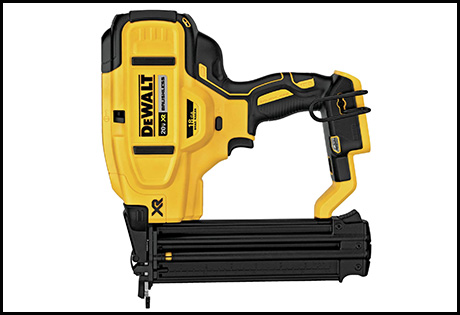
Why We Recommend This Product?
There is just no substitute for getting rid of the air hose and/or power cable. This cordless brad nailer is my top-rated choice for professionals who install trim for a living. There is no lag time between pulling the trigger and firing the brad. The battery will last all day. It never misfires. Because there is no hose, you can hold the gun at any angle with ease.
Detailed Review
Power to spare. This 18 gauge brad nailer will drive a pin into hard 4×4’s without hesitation. The brushless motor minimizes power consumption, so the batteries last a long time. There is an LED indicator on the body to help you keep tabs on the charge status.
If you have bought into the Dewalt battery system (you already know my thoughts about the battery game), then this is without question, the gun you should be buying.
That battery does mean the nailer has some heft to it. So instead of going to the gym, you can just finish that trim job you have been pushing off.
It drives brads from 5/8” up to 2 1/8-inches, and the adjustment for the load you are using is a simple one. Although it will hold up to 100 brads, many owners report that it gets a little cranky if the magazine gets down to the last ten or so, which results in occasional misfires and more frequent reloading.
Pros
- Cordless and hoseless
- Loads of power
Cons
- Pesky may misfire if the magazine approaches empty
Final Verdict
This is a great choice for professional use. The cordless design lets you work faster than dragging an air hose around. You can get this nailer into spots a hose won’t let you go. It is powerful, dependable, quiet, and just plain gets the job done. It is going to set you back around $250 on top of the battery investment, so this isn’t a cheap brad nailer. But if your livelihood depends on getting that trim work done as quickly, painlessly, and efficiently as possible then this is what you need.
DeWALT also has some superb nail guns to offer, including DC608K, D51238, and DWFP12233.
07 Ryobi P320

Why We Recommend This Product?
Battery powered nailers can put a serious dent in your budget. Ryobi is a tool maker that has tried to take the sting out of the price tag on many of their power tools, and especially their lithium battery systems. Frankly, their cordless offerings are a bit of a hit and miss venture. Some are great, while others fall very short of the power needed to satisfactorily do the job. Their “Airstrike 18” is a bullseye at a great price.
Detailed Review
For about half the price of many other battery-powered brad nailers, Ryobi saves you a lot of money up front, and a lot of time on the job site. It is quick to work with, maneuverable (thanks to its cordless power), and easy to put at any angle you need to get the job done. As with all battery powered nailers, you need to buy in to the Ryobi battery system, so you can use the same lithium batts across a range of tools. But, if you do that, this nailer won’t disappoint.
Ryobi claims up to 700 brads on a single battery charge, which means you can work all morning, charge while you have lunch, and round out the afternoon with power to spare. Another great feature that battery runs in an LED work light that not only helps you put the brad right where you need it, but lets you see it happen! This is a really great feature available on only a couple of the units in our review, but that I think should be a standard part of every brad nailer.
This woodworking tool uses 5/8” to 2-inch brads, and adjusting for the different sizes is a simple twist of the wrist. It also has a bump fire setting for making quick work of the trim task. However, I will point out that there is a small lag between pulling the trigger and having the nail driven home. If you pull the trigger, and release some of your pressure on the nose a little too quickly, it may not drive the nail all the way in. You’ll find yourself doing the final setting of the brads with a hammer. But once you learn the dance, it works great every time.
Pros
- Lower cost than most battery systems
- LED work light
- Ample power for accurate brad driving
Cons
- Slight delay between pulling the trigger and the unit firing
- Investing in the Ryobi battery system
Final Verdict
Many power tools just cost too much money for the average homeowner or wood working hobbyist. So, they go about these tasks using hand tools, eating up time, energy, and ending up with an unsatisfactory result. Ryobi tries to fill the gap with good quality tools that won’t bust the budget. This 18 gauge brad nailer can easily stand up to a side-by-side comparison with any of the cordless machines in my review. If you have decided to go with Ryobi for your battery-driven power tools, add this model to your wish list.
08 PORTER-CABLE BN200C
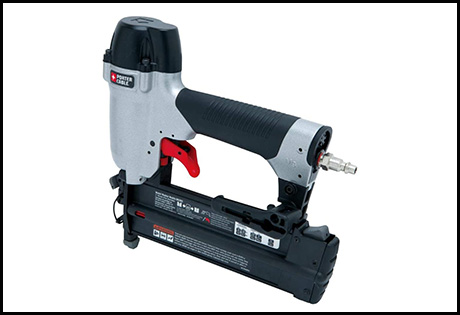
A magnesium-bodied 18 gauge brad nailer that simply won’t back down. This is a well-built, durable machine that just won’t jam or misfire. The maintenance-free design, soft tip, and sequential trigger mean that you’ll be in and out from the job in no time at all and, except for the trim being firmly tacked in place, there will be no evidence you were ever there.
My only complaint is that the body of the nailer is a little bigger than most, meaning that you may have a tough time getting it into small spaces. It is also a pneumatic system, so the air hose and compressor will be in the way as well. But it weighs much lesser than the BN200SB and BN200A.
Exhaust air ports out the back end, so it won’t be blowing dust into your work area (or face). It will fire brads from 5/8” to 2 inches in length. There aren’t a lot of bells and whistles to this nailer (i.e., no work lights, belt hooks, etc.) but it gets the job done well and it won’t break the budget.
Pros
- Maintenance-free design
- Sequential triggering
- Reasonable cost
Cons
- Basic brad nailer with no added features
Final Verdict
If you are looking for a dependable pneumatic brad nailer that just does its job without fail, then look no further. At a little below $70, it’s not exactly a cheap brad gun, but it is a durable and dependable one that will last you for many years.
09 Makita AF505N
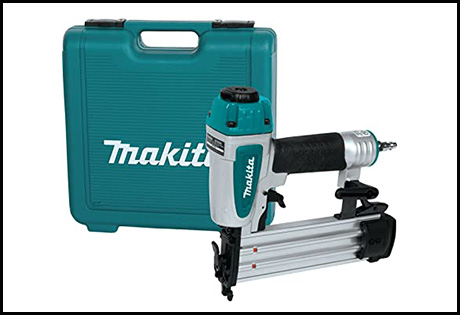
Used by a lot of professional trim carpenters, the Makita AF505N should not be overlooked. It has some nice features, like a 360° swivel exhaust port, a visible red indicator to alert you to a magazine that is getting close to empty, and a tool hook that swivels in 180°. One feature that it doesn’t have is sequential “bump” firing. This trigger setting allows for a fast work flow. Alas, not on this gun.
It also just, plain works. Many owners report firing thousands of nails without a jam or misfire, which is an astonishing performance. The nose piece is cast and then machined to exacting specs, which means it goes where you want it, makes clean contact with the work surface, and injects the brad without marring the trim wood. You can’t ask much more than that from a brad nailer.
Pros
- Minimal misfires
- Good build
Cons
- No Bump firing
Final Verdict
Makita is a brand preferred by many professional carpenters. And why not? It is a solid company with a reputation for building high quality, if not flashy, tools. This is a good brad nailer like Makita’s DBN500Z, but perhaps not a great one. The lack of features like a bump trigger, belt hook, and other little things add up to a solid brad nailer that gets the job done well, but doesn’t really stand out in the process.
10 Hitachi NT50AE2
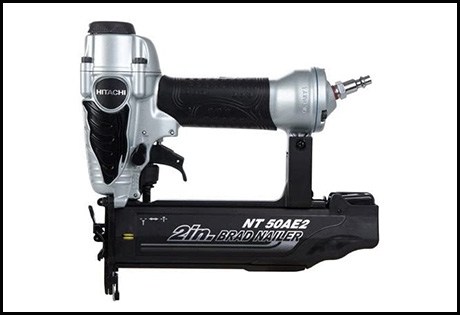
Hitachi is rebranding itself as “Metabo”, so I don’t know how long this brad nailer will be on the market. Perhaps it will come back as the very same pneumatically powered tool with a new name plate. Regardless, it is a brad nailer worthy of your consideration.
A selector switch lets you choose bump or contact firing modes. A simple dial is how you set the depth for nail loads ranging from 5/8” to 2 inches in length. This nailer also has an exhaust port that swivels 360° to optimize user comfort. Speaking of comfort, at just 2.2 pounds it is one of the lightest nailers in our comparison.
I did find the nose piece to be a bit finicky when trying to work it into certain tight spots. It’s a little larger than others and if it isn’t depressed all the way, it won’t fire. That’s normally a good thing, but in some little corners, it can be a bit of a problem. It also seems to leave a mark in the trim that is larger than the nail itself. Not a big deal if you are painting the surface, but if it is to be stained, you might not be pleased.
But it is a durable, well-made brad nailer that an overwhelming number of owners say they would buy again. You can’t argue with its success.
Pros
- Lightweight
- Dependable
Cons
- Finicky nose piece
- Leaves marks
Final Verdict
This might be the lowest rated 18 gauge brad nailer in our list, but don’t let that deter you from buying it. It is a determined workhorse that rarely misfires, has more than enough power to fully drive the brads home, and will last a good long time. I am a bit concerned about the size of the drive hole, but that might be an anomaly to the tool I used. Other finish carpenters report no such issue.
Brad Nailer Buying Guide: Things to Keep In Mind

A tool does you no good if you never use it because you don’t like the way it feels in your hand, or you aren’t satisfied with the performance of it. So, it is important to get a tool that not only does the job well every time you need it, but makes the job easier for you. Brad nailers have successfully overtaken the job of traditional frame hammers and save a lot of time for the users. Here is a list of the things you should keep in mind when choosing your 18 gauge brad nailer.
-
Power source (Air or Battery)
An air compressor is a standard tool on every job site. So, powering a brad nailer by way of a pneumatic hose is a very common practice. It has its advantages. For one, as long as there is air in the compressor tank, you have a functioning nailer. The downside is that you are dragging that umbilical hose everywhere you go. Moving quickly along a molding project, where you might encounter ladders, sawbucks, and other workers can be a challenging task.
That’s where the battery-powered brad guns come in handy. With no hoses or power cords, you can move quickly and freely. Most battery systems have enough power to keep you going on a single battery (with lunch break charging time) all day. The big downside is that Lithium Ion batteries add significant cost (and a bit of weight, too) to your nailer.
-
Depth of Drive and adjustment
Make sure that whichever nailer you choose has an accurate and easy way to set the proper depth adjustment. The last thing you want to do is go back around with a hammer and nail the little buggers in because the nailer left them a bit proud.
-
Nose Design
The nose should be small enough that you can see exactly where you are placing the brad. It should come equipped with a rubberized tip to prevent marring the wood. And the firing safety mechanism should work simply, quickly and effectively every time.
-
Trigger Type
I like nailers that allow me to switch from sequential to bump firing when the job allows. It just speeds up the work.
-
Ergonomics
Go to the store, pick up the brad nailer that you are interested in buying, and hold it in your hand as though you’re going to use it. Yes, you might get a few wary looks from other patrons. Don’t mind them. They won’t be with you at the job site. And if you don’t use your brad nailer because you didn’t try it out to see if you like the balance, weight and design of it, it was a waste of money.
-
Storage Case
Does the brad nailer that interests you come with a storage case? Is it a hard sided or soft case? Do you care, or do you have your own tool kit to keep it in. A roughly handled brad nailer can be damaged, so this is a serious consideration.
-
Tool-Free Jam Release
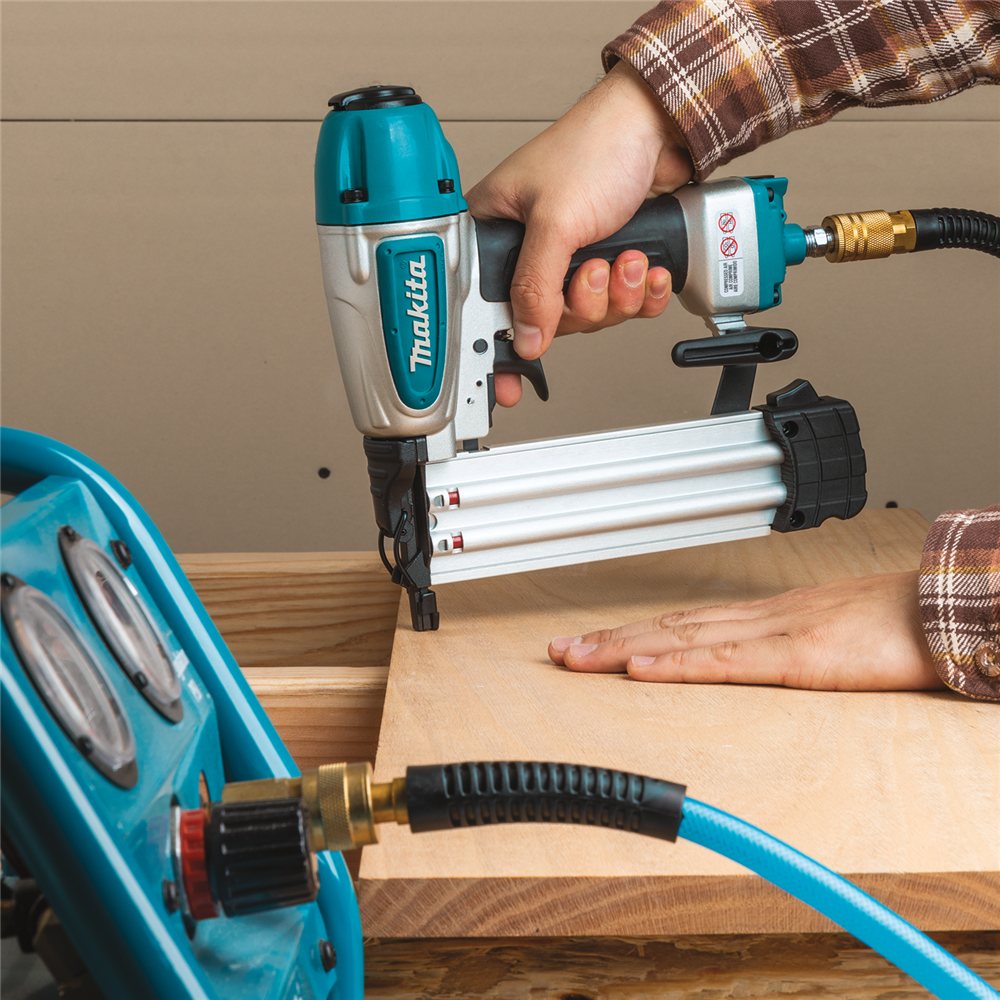
All of the brad nailers in our review are equipped with a tool-free jam release, but some others are not. Jams happen, even to the finest models with the highest ratings. It is important to be able to quickly pop the nose open and clear the jam so you can get back to work.
-
LED Lights
I personally consider this an essential feature a brad nailer can offer. If you can’t see the place where you want the brad to go, how can you be accurate? Of course, only the battery-powered nailers offer this, so it is one more argument for going cordless.
-
Anti-Dry Fire
Again, this is a standard feature but make sure the nailer you get has an anti-dry fire control. Firing without a nail in the chamber can damage and even ruin the tool.
-
Exhaust Air Control
It matters. If the exhausted air is blowing in your face or kicking up dust in your working area, it gets real annoying, real fast. I like the systems that allow the exhaust port to rotate 360°. That way you are in complete control of the environment you are working in.
-
Price & Warranty
A warranty is something you hope you never have to use. But it sure is nice to know it’s there.
As for price, unless you are a professional carpenter who spends a lot of time driving brads, you don’t have to break the budget here. Ideally, if you are choosing to go cordless, you can get a brad nailer that uses the same battery system as your other tools. It won’t even cost that much more than a pneumatic one.
Why Do You Need Such a Power Tool?
If you are building a new home, an addition, or remodeling an older home, a brad nailer is not only beneficial. It is essential. Let’s say you need to put a quarter molding around a room that has just had a new floor installed (yes, that was my task). With a good brad nailer, this would be finished in minutes.
How long would it take you to nail that flimsy piece of soft wood in place using a hammer? How many dents would you leave in that molding from the hammer head? How many times would you hit your finger with the hammer while you tried to hold those tiny nails in place? How many times would you cause the molding to split? How many times would you utter words so nasty that your dog would cringe?
I think you get my point. If your woodworking projects involve nailing small pieces of wood trim, whether it’s on flooring projects, furniture or cabinetry, you need to look for the best 18 gauge brad nailer out there.
About Brad Nailers
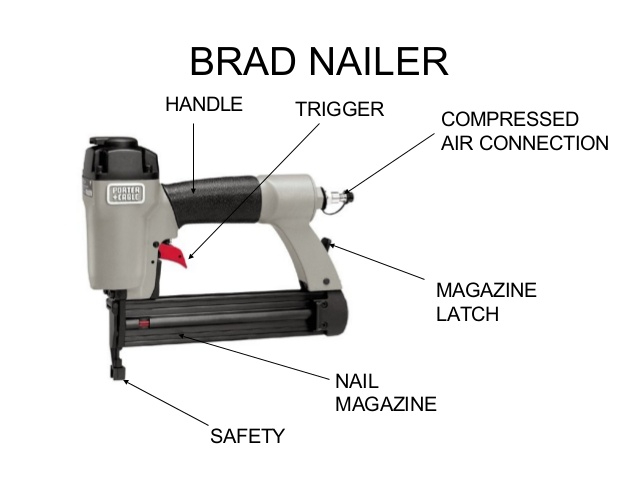
What is a Brad Nailer?
Brad nailers do one job. They fire 18 gauge (in other words, very thin) brads into trim and other small wood pieces to mate them to larger elements. They drive the brad into the wood, so that no nail head is visible. This is how most wood floor trim and a lot of cabinetry trim is held in place. You can do this with a hammer, but why? You will end up with hammer head dents in your wood, visible nail heads, and a lot of time spent doing a job that could have been done in a flash.
When Should You Use Brad Nailers?
The only time to break out the brad nailer is when you are doing these small trim pieces. It doesn’t use nails that are large enough to frame or mate substantial pieces of wood together. It is strictly for the trim finishing projects. That means it will spend a lot of time in your tool box collecting dust. But when you need it to give a project that polished and professional look, no other tool will do.
The primary jobs that brad nailers are designed strictly for finish trimming. If you just had new flooring laid, the quarter round molding that covers the seam where that floor meets the walls is the perfect task for a brad nailer. An entire length of molding can be securely mated in place in seconds with a brad nailer. By hand, you could spend 20 profanity-laced minutes doing the same job with inferior results.
How Brad Nailers Are Different from Other Types of Nailer?
Brad nailers have the upper hand over most of the other types of nail guns. Put simply, this all has to do with the size of the nail being driven. It might seem like a nail gun should be able to fire any size nail, with reason. But it just isn’t so. The piston that drives the nail must match the exact size of the nail, or it will leave an ugly gash in the surface of the trim pieces you are nailing in place. If you want to drive a bigger nail, get a bigger hammer.
-
Brad nailer vs finish nailer
A finish nailer uses larger nails capable of mating larger pieces of wood together. These larger fasteners simply have more strength. So, let’s say you have decided to take on the task of installing the baseboard and quarter molding in the room where you just had a new carpet laid. You are going to use a finish nailer to install the baseboard, and then switch to the brad nailer to install the quarter molding.
-
Brad nailer vs pin nailer
A pin nailer fires an even smaller projectile than a finish nailer. “Pins” are very thin nails used for the most delicate of attachment tasks. Brads are 18 gauge and pins are 23 gauge nails – that’s only slightly larger than the diameter of a common staple. Pins are only used on the tiniest of trim pieces and are frequently paired with another fastener, such as glue or other adhesive.
Brad Nailers Usage, Maintenance & Safety Guide
How to Use Brad Nailers?
Remember that brads are 18 gauge fasteners, essentially pieces of very stiff wire, that are used for fastening smaller trim pieces. Brads do not have a lot of holding power and are not suitable for any job that requires the mated piece of wood to bear any stress. They are made to hold small pieces of trim in place, and that’s it. They are perfect for this task because their larger finish nailer counterpart, in many cases, would cause the small trim pieces to actually split.
Brads also have no significant head, so they are designed to sink just below the surface of the trim piece, and essentially become invisible. You place your molding where you want it, snugly seat the nose against the wood, and pull the trigger. The brad is driven home in the blink of an eye.
Safety Tips
Never, ever point a brad nailer at another living creature. Keep your fingers away from the point of any live and loaded nailer. Always wear safety glasses when using one of these tools. They can and do sometimes kick up enough dust to really irritate your eyes.
Used properly, a brad nailer is a relatively safe tool to operate. But remember that it is firing a sharp projectile under a lot of force and you never want to be on the receiving end of that.
Maintenance Tips
Some pneumatic 18 gauge brad nailers need an occasional drop of oil to be sent through the airway to keep everything operating smoothly inside. Many do not. Battery powered systems generally don’t require any oiling, but the batteries do require careful handling and proper charging to continue delivering the power you need.
When not in use, keep your brad nailer safely tucked away in its case or other protective storage location. Water, dirt, and dust are the enemies of all power tools, and brad nailers are no exception.
Whichever brad nailer you choose, be sure to read the maintenance recommendations in the manual. Follow their suggestions, and the machine will give you great service for many years to come.
It’s Time to Wrap Up
I have worked very hard to give you a valid comparison of what I consider to be the highest quality brad nailers on the market. I do this without regard to brand names because I believe that accomplishing the job at hand is far more important than the nameplate on the side of the nailer.
This review is a great place for you to start your search for a brad nailer. The next thing you need to do is conduct your own research. Go to the store and look at them. Pick them up and feel them in your hands. Then think about the things I and the thousands of real-world owners whose opinions I have taken into account had to say about each tool. Only now are you ready to make your own decision and buy the 18 gauge brad nailer that is right for you.
FAQs
Q: Can I use a brad nailer for baseboards?
Ans: Yes you can. A brad nailer has enough power to dig into half-inch thick baseboards without any problem.
Q: Are Brad nails interchangeable?
Ans: You can interchange the 18 gauge brad nails.
Q: What is the longest Brad nail?
Ans: 15 gauge brad nails a diameter of 1.9mm are the longest in this category.


